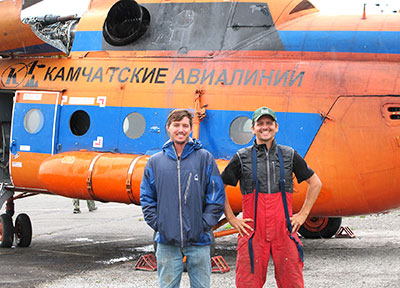
Hawaiʻi is no stranger to the plight of endangered plants and animals and the reality of extinction. Yet nothing provides quite as much scientific intrigue as the fate of the world’s largest animals.
In Hawaiʻi, there is the moa-nalo, a large goose-like duck that once roamed the islands before human arrival. In the Arctic, there is the woolly mammoth.
The cause of the extinction of the woolly mammoth, which went extinct between 10,000 and 4,000 years ago, has been the source of debate amongst scientists for decades. Some have argued that hunting by humans was the culprit, while others believe climate change was to blame.
According to recent findings by a research team including University of Hawaiʻi at Mānoa Assistant Professor David Beilman, it was in fact a lethal combination of climate warming, encroaching humans and habitat change—the same threats that face many species today—that led to the demise of the woolly mammoth.
“We were interested to know what happened to this species during the climate warming at the end of the last ice age because we were looking for insights into what might happen today due to human-induced climate change,” said lead author Glen MacDonald, a UCLA scientist. “The answer to why woolly mammoths died off sounds a lot like what we expect with future climate warming.”
Beilman worked with MacDonald and other researchers from UCLA, UC Santa Cruz and the Russian Academy of Sciences on the study, which was published in a recent issue of the journal Nature Communications.
Radiocarbon-dated evidence
By combining radiocarbon-dated mammoth remains with genetic data, archaeological data, and climate reconstructions over the last 50,000 years, the researchers argued that the extinction didn’t line up with any single change, but with the combination of several new pressures on woolly mammoths.
The new research marks the first time scientists mapped out and dated so many different aspects of the era at once. Using geo-referenced fossils and radiocarbon dating, the researchers were able to trace the changing locations of peatlands, forests, plant species, mammoth populations and human settlements over time, and they cross-referenced this information with data on long-term climate change.
Beilman, an environmental scientist who studies climate change and other impacts on terrestrial ecosystems, worked on the analysis and interpretation of the spatial and temporal data, radiocarbon age calibration and mapping.
“The final curtain of these big mammals really captures the imagination as you consider the multiple factors that can lead to extinction,” said Beilman, who collaborated on this project for a number of years prior to and since joining the UH Mānoa Department of Geography in 2009.
Implications for Hawaiʻi’s endangered species
Of course, woolly mammoths never existed in Hawaiʻi, but Beilman believes the long sunset of the mammoth offers some relevant lessons for the islands.
“Hawaiʻi is the last home of so many endangered species that are experiencing multiple pressures. Gaining a better understanding of the many factors that can combine and interact to potentially drive a species to extinction is important for Hawaiʻi,” said Beilman. “Not unlike the situation with the mammoths, it’s not just humans but also rapid climate variation and change that are significant challenges to our efforts to conserve native Hawaiian species like birds, land snails and the Hawaiian monk seal.”
Beilman just returned from mammoth territory, the Kamchatka Penninsula in the North Pacific, where he participated in a month-long field excursion studying soil carbon histories using sediment cores.
“The whole region is strongly interconnected by the raw power of the ocean and the atmosphere,” said Beilman. “Understanding the climate and environment of the North Pacific is important for us to know how our islands developed and how they may respond in the future to multiple global changes.”

